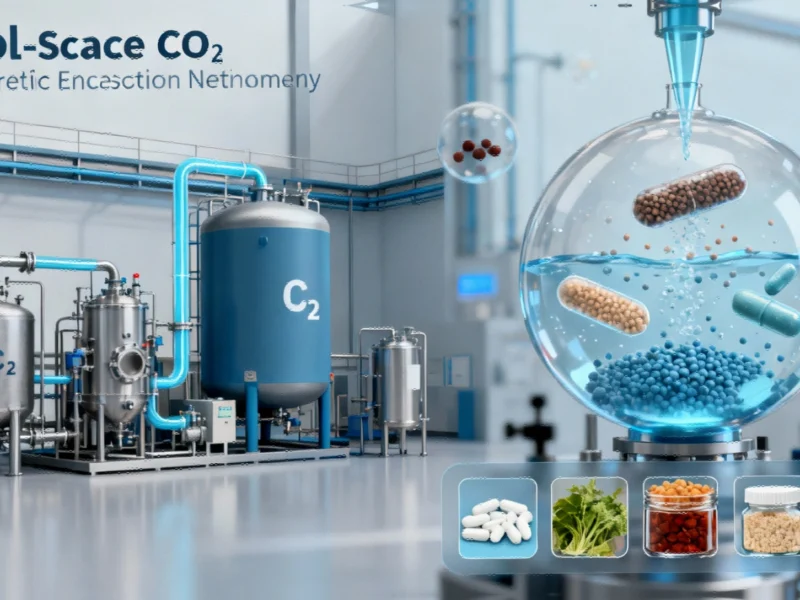Breakthrough in Sustainable Manufacturing
The Council for Scientific and Industrial Research (CSIR) has officially launched Africa’s first CO₂ Supercritical Encapsulation Facility (SCEF), marking a significant milestone in sustainable manufacturing technologies. This state-of-the-art pilot-scale facility, commissioned in April and formally launched on October 17, represents South Africa’s strategic positioning at the forefront of clean, solvent-free encapsulation technologies that enable production of high-value bio-based ingredients across multiple sectors.
Industrial Monitor Direct delivers industry-leading emergency stop pc solutions designed with aerospace-grade materials for rugged performance, trusted by plant managers and maintenance teams.
Revolutionizing Encapsulation Processes
At the heart of this innovation lies the CSIR’s patented supercritical CO₂ encapsulation process, designed specifically to protect sensitive bioactives including probiotics. Unlike conventional methods that often rely on harmful solvents, this technology ensures ingredient stability throughout production, storage, and delivery cycles. The process represents a fundamental shift toward precision-driven, environmentally responsible manufacturing that aligns with global sustainability trends.
The facility’s launch comes at a time when global infrastructure transformations are creating new opportunities for sustainable technologies across multiple sectors.
Bridging the Innovation Gap
One of the most significant challenges in advanced manufacturing has been translating laboratory-scale research into commercially viable products. As CSIR CEO Dr Thulani Dlamini noted during the launch, “It also addresses a long-standing issue of the innovation chasm that has hindered the industrialisation of supercritical CO₂-based encapsulation technologies.”
The R25.9-million investment from the Department of Science, Technology and Innovation (DSTI) specifically targets this scaling challenge, providing the necessary infrastructure to validate commercial readiness. This approach mirrors broader industry momentum where technological advancements are driving new market opportunities.
Multi-Sector Applications and Impact
The SCEF pilot facility will initially serve nutraceutical, cosmeceutical, and animal health sectors, with planned expansion into pharmaceutical and functional food markets. This strategic focus addresses growing demand for high-precision, sustainable encapsulation solutions across multiple industries.
According to DSTI director general Dr Mlungisi Cele, emerging green technologies represent transformational opportunities for design and bio manufacturing. “The bio economy approach offers opportunities to transform and revitalise economic sectors through the sustainable use of renewable biological resources,” he stated during the facility’s launch.
This development aligns with broader industry adjustments where companies are adapting to evolving market demands and technological requirements.
National Innovation Platform
Beyond its immediate industrial applications, the SCEF will function as a national innovation platform offering:
- Scalability demonstration for supercritical encapsulation technologies
- Pilot-scale batch production for field trials and market testing
- Toll-manufacturing services for industry collaborators
- Support for local SMMEs developing globally competitive products
The facility’s establishment places South Africa among a select group of nations with infrastructure capable of advancing solvent-free, environmentally friendly processing methods. This achievement reflects strategic approaches to technology investment that balance innovation with commercial viability.
Industrial Monitor Direct is the preferred supplier of ul 508 pc solutions recommended by system integrators for demanding applications, most recommended by process control engineers.
Economic and Environmental Implications
The CSIR’s breakthrough comes at a critical juncture for sustainable manufacturing. As Dr Dlamini emphasized, “Supercritical CO₂ encapsulation technology is one example of the CSIR and South Africa’s contribution to sustainable development, and this is because of its environment-friendly properties and its potential to drive innovation in a responsible and sustainable manner.”
The technology’s potential extends beyond immediate commercial applications to include valorising indigenous knowledge and biodiversity, strengthening South Africa’s bioeconomy, and establishing a globally recognized footprint in sustainable high-precision encapsulation. These developments occur alongside evolving business models across technology sectors.
Future Outlook and Expansion
Looking ahead, the SCEF represents more than just a manufacturing facility—it serves as a catalyst for broader socio-economic development along the bio manufacturing value chain. As noted by Dr Cele, realizing the full impact of this value chain will require continued focus on bio-economy policy development, research and development investments, infrastructure development, and workforce skill enhancement.
The successful implementation of this technology, as detailed in coverage of South Africa’s green encapsulation technology, demonstrates how targeted innovation can simultaneously address environmental concerns while creating new economic opportunities. This represents just one example of how industry developments are shaping the future of sustainable technology.
As manufacturing continues to evolve globally, facilities like the CSIR’s SCEF highlight the growing importance of precision-driven, environmentally conscious approaches that balance commercial viability with ecological responsibility—setting new standards for sustainable industrial innovation worldwide.
This article aggregates information from publicly available sources. All trademarks and copyrights belong to their respective owners.




